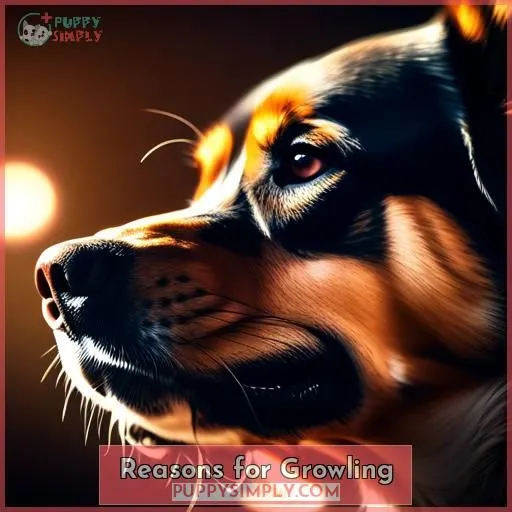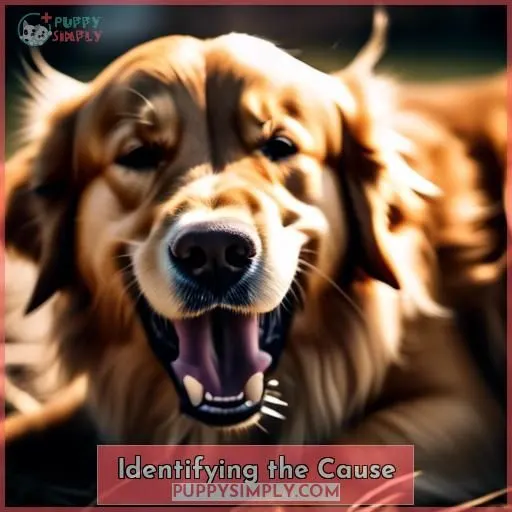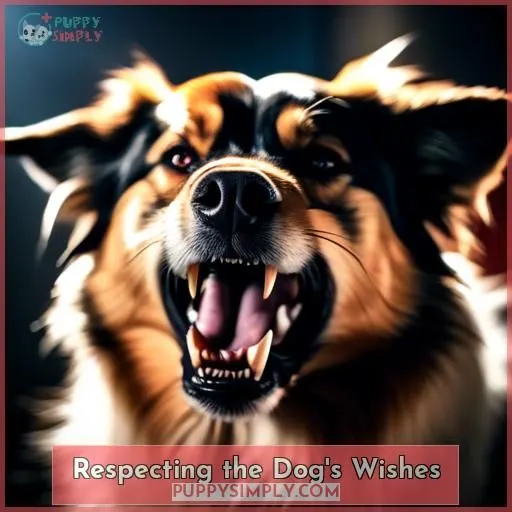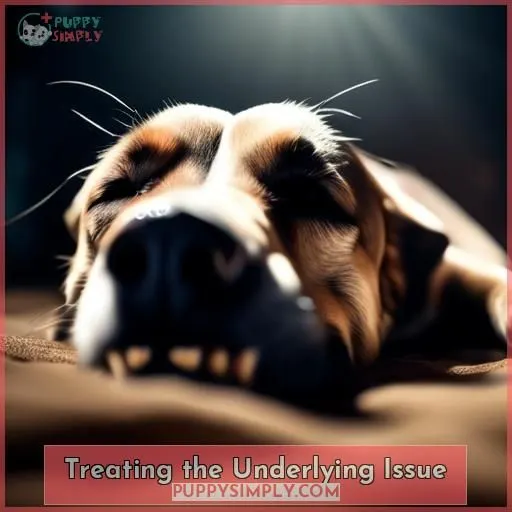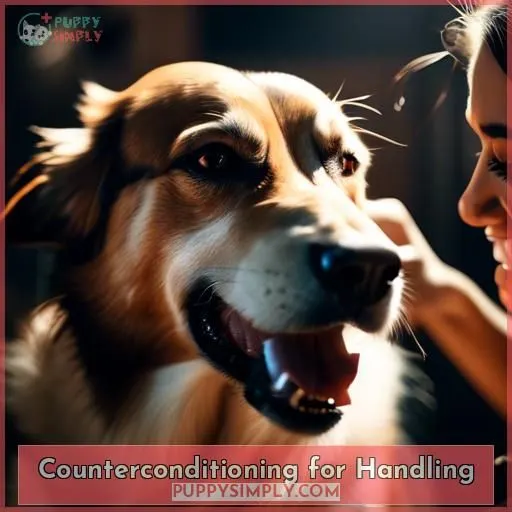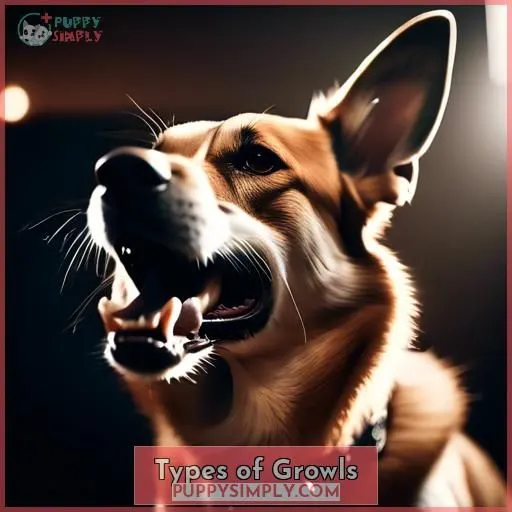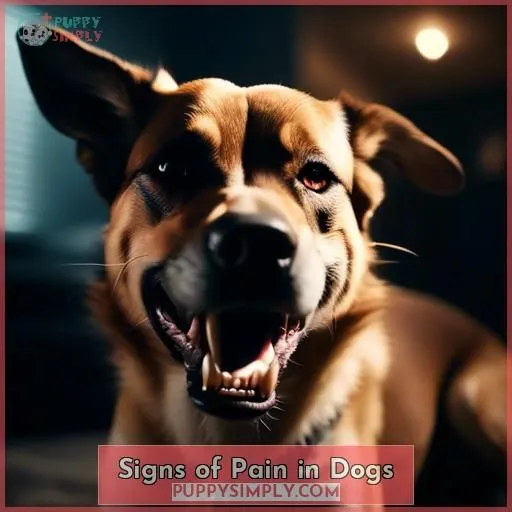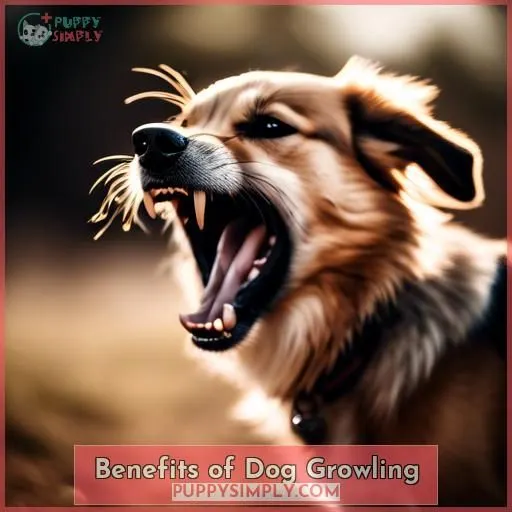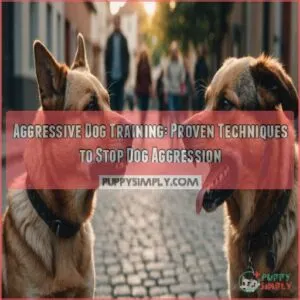This site is supported by our readers. We may earn a commission, at no cost to you, if you purchase through links.
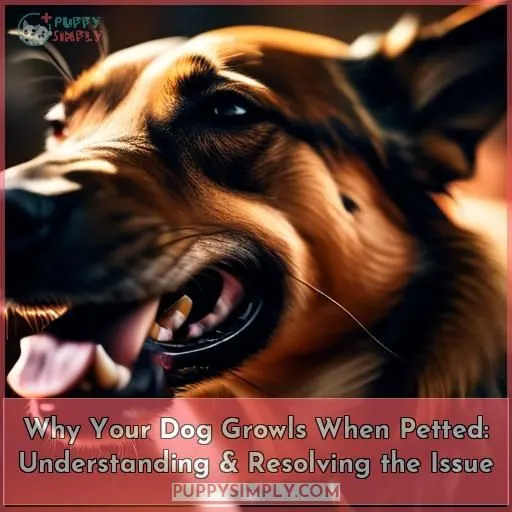
Your dog growls when petted because they are communicating discomfort, fear, or a need to set boundaries.
It could stem from an uncomfortable petting style, pain, or fear of humans.
Observe your dog’s behavior and body language carefully when approached. Experiment with different petting techniques to find what they prefer.
Rule out medical issues with a vet checkup.
If your dog seems fearful, focus on building trust gradually.
Respecting your dog’s growls and addressing the underlying cause will strengthen your bond.
For a deeper understanding of why your dog growls when petted and how to resolve it, keep exploring.
Table Of Contents
- Key Takeaways
- Why Your Dog Growls When Petted?
- Reasons for Growling
- Identifying the Cause
- Respecting the Dog’s Wishes
- Treating the Underlying Issue
- Counterconditioning for Handling
- Types of Growls
- Signs of Pain in Dogs
- Benefits of Dog Growling
- Frequently Asked Questions (FAQs)
- What should I do if my dog growls when I pet her in a specific area?
- How can I tell if my dog’s growling is due to pain or discomfort?
- Can my dog’s growling be a form of communication, or is it always a warning sign?
- How can I help my dog feel more comfortable during petting sessions?
- What are some signs that my dog is experiencing stress or anxiety?
- Conclusion
Key Takeaways
- Dogs growl when petted due to discomfort, fear, or a need to set boundaries.
- Fear of humans, uncomfortable petting styles, and pain or discomfort can cause growling.
- To resolve growling during petting, observe your dog’s behavior, experiment with different petting techniques, and rule out medical issues.
- Building trust with your dog and respecting their growls can strengthen your bond.
Why Your Dog Growls When Petted?
Your dog may growl when petted due to several reasons. It could be because they’re scared of you, in pain, or because you’re petting them wrong by not understanding their preferred petting style. Additionally, some dogs may growl when they’re in discomfort or anxious, which could be due to sensitivity in certain areas or pain. It’s essential to respect your dog’s wishes and avoid punishing them for growling, as this can exacerbate the underlying issue. Instead, try to determine what’s bothering your dog and address the underlying issue to help your dog become more comfortable with petting.
Reasons for Growling
If your dog growls when being petted, it could stem from fear of humans, discomfort with the petting style, or underlying pain or discomfort. These causes warrant close observation of your dog’s behavior when approached, experimenting with different petting techniques, and ruling out medical issues through a veterinary checkup.
Fear of Humans
As a responsible pet owner, it’s paramount to comprehend why your dog growls during petting. One common cause is trepidation of humans. This fear can originate from shyness, socialization concerns, past trauma, or anxiety. Dogs may growl when they’re uneasy or fearful, which can be a cautionary sign of potential hostility. To resolve this issue, it’s imperative to foster trust with your dog, adapt your petting style to their preference, and address any underlying pain or discomfort.
Fear of humans can manifest in various ways, such as aggressive chewing, cowering, or holding their head lower than their back. In some cases, fearful dogs may even have housetraining accidents or display exaggerated yawning. It’s essential to acknowledge these signs and take steps to help your dog feel more at ease around people.
To ascertain the cause of your dog’s fear, observe their behavior when approached. Experiment with different petting styles and rule out medical issues through a veterinary checkup. If necessary, seek professional assistance to guarantee your dog’s well-being.
Uncomfortable Petting Style
Your dog’s growling when petted may be due to an uncomfortable petting style.
Some dogs have different petting preferences and sensitivity to touch.
Observe your dog’s body language for signs of discomfort, such as stiff posture or growling.
Adjust your petting style to be more gentle and in line with your dog’s touch tolerance.
Pain or Discomfort
Just as a thorn in your side can make you jump, your dog’s growl might be a red flag for health concerns.
Painful petting, due to an unnoticed injury or medical condition, can turn a cuddle session sour.
If your furry friend’s growls hint at discomfort, it’s time for detective work—think veterinarian consultation, not punishment—to address the pain causing the growling and guarantee their tail-wagging happiness.
Identifying the Cause
To identify why your dog growls when petted, closely observe their behavior when you approach and make contact. Experiment with different petting styles, locations, and pressure to determine if the growling stems from an uncomfortable handling technique. Additionally, rule out potential medical issues by scheduling a thorough veterinary examination, as pain or discomfort can manifest in growling during petting sessions.
Observe Dog’s Behavior When Approached
When approaching your dog, observe its behavior carefully. If it growls, pay attention to its body language, tone, and pitch. Stiff posture, hard stares, and a high-pitched growl may indicate fear or stress. Submissive grins or play bows, on the other hand, suggest happy growls. Understanding these differences can help you determine the underlying issue and respond appropriately.
Experiment With Different Petting Styles
Experimenting with different petting styles can help you identify why your dog growls when petted.
Dogs have preferences for how they’re touched and may growl when petting isn’t enjoyable for them. Some dogs may not like being touched on certain body parts or in specific directions. For example, a dog might enjoy a gentle face rub but dislike a head pat or a hard scratch on the back.
To find out what your dog likes, try petting them in different ways and observe their reactions. If your dog moves closer for more petting, you’ve found a style they enjoy.
This method, known as pat-pet-pause, can also help children and strangers learn to interact with dogs** more appropriately.
Rule Out Medical Issues Through Veterinary Checkup
If your dog is growling when you pet it, it’s critical to eliminate any underlying medical problems that could be causing the discomfort. Arrange a veterinary examination to evaluate your dog’s overall health and identify any potential medical conditions that may be causing the growling.
During the checkup, your veterinarian may conduct a physical examination, draw blood, or perform imaging studies to determine if your dog is experiencing pain or discomfort. They may also inquire about your dog’s behavior and any recent changes in its environment that could be contributing to the growling.
If your dog is diagnosed with a medical condition, your veterinarian will provide appropriate treatment, such as medication or physical therapy, to help alleviate the discomfort and enhance your dog’s quality of life.
Respecting the Dog’s Wishes
When your dog growls during petting, it’s essential to heed their limits. You should cease petting immediately, refrain from penalizing the growling behavior, and offer a treat to facilitate the calming of the situation and mend the connection with your furry companion.
Back Off and Avoid Punishment
When your dog growls while being petted, it’s vital to honor their wishes and avoid reprimanding them.
Reprimanding your dog for growling can result in exasperation and aggression, which is counterproductive.
Instead, concentrate on discerning the underlying reason for the growling and implementing avoidance strategies.
This could entail adjusting your petting style, addressing any pain or discomfort, or establishing trust with your dog through positive reinforcement.
Offer Treats to Repair Relationship
When your dog’s soft growl signals a plea for space, respect their wishes and retreat.
To mend fences, offer treats, fostering trust and affection.
This silent communication speaks volumes, transforming tension into a chance for bonding.
Focus on Making Petting Enjoyable
Focus on making petting enjoyable to respect your dog’s wishes. Here’s how:
- Experiment with petting techniques: Find what your dog enjoys. Some dogs prefer gentle, long strokes, while others enjoy short, firm pats.
- Create pleasurable experiences: Reward your dog with treats or praise during petting sessions to make them associate it with positive experiences.
- Based training: Use positive reinforcement training methods to build trust and strengthen your bond through touch.
- Bonding through touch: Offer a higher-pitched growl as a sign of affection and trust. Consult a dog trainer or animal behaviorist if needed.
Treating the Underlying Issue
To treat the underlying issue causing your dog to growl when petted, you must first build trust with a fearful dog through positive reinforcement and gradual exposure. Additionally, you should adjust your petting style to accommodate your dog’s preferences and address any underlying pain or discomfort through proper veterinary care.
Build Trust With Fearful Dogs
Fostering trust with apprehensive dogs is essential for addressing their growling behavior. Commence by implementing positive reinforcement, such as treats and commendations, to establish a favorable connection with petting. Progressively expose your dog to handling through desensitization and counterconditioning techniques. Exercise patience and consistency, and your dog will eventually learn to rely on you, diminishing their growling behavior.
Adjust Petting Style to Dog’s Preference
Understanding your dog’s preferences is essential for a harmonious petting experience.
Different breeds and ages may require different petting techniques.
Hand positioning is also important.
For instance, older dogs may prefer gentle strokes, while younger ones might enjoy more energetic petting.
Building trust is key.
Observe your dog’s reactions and adjust accordingly.
Address Any Underlying Pain or Discomfort
Addressing any underlying pain or discomfort is essential when your dog growls during petting. Here’s how:
- Conduct a pain assessment: Observe your dog’s behavior and body language for signs of discomfort.
- Seek medical treatment: If necessary, consult with a veterinarian for a physical examination and potential treatment options.
- Rule out underlying illness: A veterinary consultation can help identify any medical conditions contributing to your dog’s growling.
- Treat the underlying issue: Once diagnosed, follow the recommended treatment plan to alleviate your dog’s pain or discomfort.
Counterconditioning for Handling
To address your dog’s growling during petting, you should gradually expose them to handling while providing positive reinforcement through treats and praise. This counterconditioning process aims to create positive associations with being handled, ultimately making the experience more enjoyable for your dog.
Gradually Expose Dog to Handling While Providing Positive Reinforcement
Once you’ve pinpointed the triggers causing your furry friend’s growls, it’s time for a gentle push in the direction of change. With desensitization techniques, introduce them to handling bit by bit, always pairing it with a tasty reward. This gradual exposure, a cornerstone of reward-based training, transforms wary woofs into wagging tails, building positive associations one pet at a time.
Use Treats and Praise to Create Positive Associations
To create positive associations with handling, use treats and praise as rewarding reinforcement. Incorporate desensitization techniques and counterconditioning methods to help your dog associate handling with positive experiences. Trust building is essential, so be patient and consistent. Remember, the goal is to make petting enjoyable for your dog, not a source of stress or discomfort.
Implement Procedures Outlined in Linked Articles1
To effectively address your dog’s growling when petted, it’s essential to implement the procedures outlined in the linked articles.
Counterconditioning for handling involves gradually exposing your dog to handling while providing positive reinforcement. Use treats and praise to create positive associations.
This method helps your dog associate handling with positive experiences, reducing the likelihood of growling. Remember, patience and persistence are key in this process.
Types of Growls
Dogs growl for various reasons during petting, ranging from pleasure and play to fear, frustration, and aggression. Recognizing the type of growl is essential, as it provides insight into your dog’s emotional state and the appropriate course of action.
Threat or Fear Growl
When your dog growls during petting, it’s essential to decipher the nature of the growl.
A menacing or apprehensive growl serves as an alert.
It could stem from a phobia of humans, an irksome petting technique, or discomfort.
Monitor your dog’s demeanor when approached.
Try out different petting styles and eliminate any medical concerns.
Should the growl indicate a threat, retreat and refrain from punishment.
Offer treats to mend the bond and prioritize making petting a positive experience.
Address any underlying pain or discomfort.
Foster trust with fearful dogs.
Play Growl
Play growls are a type of growl that occur during playtime or cuddling. They indicate fun and excitement, not aggression.
However, it’s essential to understand the context and body language signals to differentiate between play growls and other types of growls. Pay attention to tonal variations and your dog’s body language.
If you’re not sure, treat all growls as threats. Setting play biting limits and discouraging growls can help avoid confusion and make sure enjoyable interactions with your pet.
Frustration Growl
Frustration growls are common in dogs and can be triggered by various factors. As a pet owner, it’s imperative to identify these triggers and redirect your dog’s behavior to prevent frustration from escalating.
This might involve adjusting your petting style or addressing underlying issues, such as boredom or lack of mental stimulation.
Pleasure and Affection Growl
Your dog’s joyful growl is a sign of pleasure and affection, often heard during playtime or cuddling.
It’s a clear indication that your furry friend is relaxed and content.
This growl helps strengthen the bond between you and your dog, creating a deeper connection.
To encourage more of these happy growls, focus on making petting enjoyable and adjust your petting style to your dog’s preference.
Aggression Growl
If your dog growls when petted, it could be due to aggression.
Aggression growls are often triggered by fear, dominance, resource guarding, or fear aggression.
To address this issue, you need to determine the cause and eliminate the triggering situation.
You can also use desensitization and counterconditioning techniques to change your dog’s attitude.
Socialization and proper training can also help prevent aggression growls.
Signs of Pain in Dogs
If your dog growls when you touch a particular body part, it could signify pain or discomfort in that area.
Other signs that your dog is experiencing pain include yelping, exhibiting a fearful growl, moving away from being touched, or even nipping.
These behaviors indicate that you should have your veterinarian examine your dog to identify and treat any underlying medical issues causing the pain.
Growling When Touched at a Particular Body Part
Growling when touched at a particular body part can be a sign of pain or discomfort in dogs. If your dog growls when you touch a specific area, it may indicate that the dog is experiencing pain localization. In such cases, it’s important to consult a veterinarian for a physical examination to rule out any underlying medical conditions that could be causing the pain.
A veterinary checkup is necessary to diagnose the cause of the pain. The veterinarian may perform a complete blood count, biochemistry panel, urinalysis, and fecal exam to rule out potential causes. Ultrasounds, x-rays, or MRI may also be ordered to look internally for any tumors, bladder or kidney stones, or fractures.
Treatment for pain in dogs depends on the actual diagnosis. Once the veterinarian has determined the cause of your dog’s pain, they’ll discuss your treatment options and your dog’s prognosis. Pain medications and anti-inflammatory medications may be prescribed to make your dog comfortable before and during the recovery process.
It is essential to follow the veterinarian’s advice regarding the treatment plan and recovery time. In some cases, such as cancer that’s in the later stages, the prognosis may be very guarded, and the focus should be on managing the dog’s pain and ensuring a comfortable quality of life.
Yelping or Fearful Growl
If your dog is yelping or exhibiting signs of trepidation when you pet them, it may be an indication of pain or unease. It’s crucial to ascertain the underlying reason for this behavior to facilitate your dog’s comfort. Begin by observing your dog’s demeanor when approached, experimenting with various petting techniques, and eliminating any medical concerns through a veterinary examination.
Once you’ve identified the cause, you can take measures to honor your dog’s preferences. Withdraw and refrain from punishment, offer treats to mend the connection, and concentrate on making petting pleasurable for your dog. If your dog is apprehensive, foster trust by gradually exposing them to handling while providing positive reinforcement. Modify your petting style to align with your dog’s preference and address any underlying pain or discomfort.
If you’re uncertain about the cause of your dog’s growling, seek professional assistance. A veterinarian or canine behaviorist can offer guidance and recommend appropriate interventions.
Moving Away or Nipping
Moving away or nipping can be signs of pain in dogs.
These behaviors may indicate that your dog is experiencing discomfort or fear.
If your dog suddenly avoids petting or becomes aggressive when touched, it could be a sign that they’re in pain.
Look for other signs of pain, such as whimpering, limping, or refusing to play with their favorite toys.
If you suspect your dog is in pain, consult a veterinarian to rule out any medical issues.
In the meantime, try to minimize stress and provide a comfortable environment for your pet.
Benefits of Dog Growling
You shouldn’t view your dog’s growling as an aggressive or negative behavior. Growling serves as a crucial communication tool, allowing your dog to express discomfort, pain, or affection while preventing escalation to more severe behaviors like biting. By understanding and respecting your dog’s growls, you can build a stronger bond based on shared trust and understanding.
Communication Tool to Express Discomfort, Pain, or Affection
Your dog’s growls are more than just a warning sign. They’re a form of communication that can express discomfort, pain, or affection.
By understanding your dog’s growls, you can build a stronger bond, prevent aggression, and even use desensitization techniques to help your dog feel more comfortable with handling.
So, the next time your dog growls, don’t punish them. Instead, listen and respond with empathy and understanding.
Prevents Aggression by Providing a Warning
Your dog’s growls aren’t just a warning of aggression, they’re a form of communication. Growling can prevent aggression by providing a warning when your dog is uncomfortable or in pain. By understanding and addressing the underlying causes, you can help your dog feel more comfortable and prevent potential aggression.
Helps Build a Stronger Bond Between Humans and Dogs1
Growling isn’t just a warning; it’s a powerful communication tool that helps build a stronger bond between humans and dogs. When your dog growls, it’s saying, Hey, I’m uncomfortable, scared, or in pain. Please back off, and let’s find a way to make this better. By understanding and addressing the underlying issues, you can create a safer, more enjoyable environment for both you and your furry friend. Here are three ways growling helps:
- Communication: Growling allows your dog to express discomfort, pain, or affection, fostering a deeper understanding between you.
- Bonding: By acknowledging and addressing your dog’s growls, you demonstrate empathy and respect, strengthening your bond.
- Safety and Prevention: Growling prevents aggression by providing a warning, helping to maintain peace and preventing potential biting incidents.
Frequently Asked Questions (FAQs)
What should I do if my dog growls when I pet her in a specific area?
Pay attention to your dog’s body language. If she growls when you touch a certain area, it could indicate pain or discomfort. Gently investigate if she’s injured there, and consult your vet if the growling persists – they’ll help get to the root cause.
How can I tell if my dog’s growling is due to pain or discomfort?
If your pup yelps, moves away, or nips when you touch a specific area, that’s likely a sign of discomfort or pain. By closely observing their reactions during petting, you can identify potential issues needing veterinary attention.
Can my dog’s growling be a form of communication, or is it always a warning sign?
You’d be surprised – 25% of growls are actually a dog’s way of communicating happiness or playfulness. But context is key: body language and the situation reveal if it’s a friendly growl or a warning sign needing attention.
How can I help my dog feel more comfortable during petting sessions?
Pay close attention to your pup’s body language and signals during petting sessions. Go slow, let them sniff your hand first, and avoid sensitive areas until trust is built. With patience and positive reinforcement, your furry friend will feel safe and enjoy those cozy cuddles!
What are some signs that my dog is experiencing stress or anxiety?
Did you know 70% of dogs exhibit some stress when petted? Look out for whale eyes, lip licking, yawning, or stillness – telltale anxiety signs. Their body language speaks volumes; respect your pup’s needs to build lasting trust.
Conclusion
Around 30% of dogs growl when petted, highlighting the importance of understanding why your dog growls when petted.
By carefully observing your dog’s body language, respecting their boundaries, and addressing underlying causes through trust-building, counterconditioning, or medical treatment, you can resolve this issue and strengthen your bond.
With patience and the right approach, you can make petting an enjoyable experience for both you and your furry companion.

